Philippines

I remember the first time I asked Mary to pray for me. It was at the height of the George Floyd protests in June 2020.
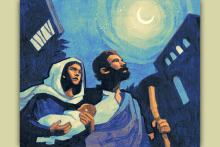
IN ADVENT, I remember and am grateful for all the prophets who show us the way of the divine. They invite us to remember and live out God’s command to love each other as much as we love God. I call to mind biblical scholar Walter Brueggemann, who passed away this year. He was a mentor, teacher, and colleague to many, including me. He taught us to prophetically reimagine a world where we challenge dominant and oppressive ideologies while compassionately re-envisioning a more just world. His magnanimous presence and prophetic words will be missed.
I also remember the young—led by Mary, the mother of Jesus—who invite us to be prophetic during adversity. With the guidance of Osvaldo D. Vena, we are invited to dream dreams in the joyous playground of God. Grounded in the abundance of God in our lives, I celebrate with Son Kyung Min’s praise song “Grace,” which I highly recommend for personal devotion and corporate worship services. The music grounds me in my faith and prompts me to remember how surrounded I am by God’s love.
As we approach the season of Christmas, let us pay close attention to the needs of our neighbors, especially our international students and immigrant neighbors. Every moment provides an opportunity for us to share the gift of the redemptive love of God.
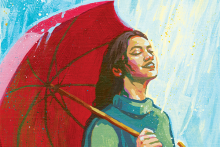
AMID RESISTANCE AND the fight for liberation, we must be humble, seek God’s mercy and love, and be willing to learn from one another. We cannot go around virtue signaling while believing we have no shortcomings.
This month’s reflections focus on repentance. I seek to confess and repent. Not with false humility or performative self-deprecation, but to be genuinely self-critical as I examine my conscience. The passages from Jeremiah and the psalms tremendously help with reorienting ourselves and our moral compass toward God. The New Testament readings strengthen us to continue doing the godly and righteous work of the Spirit. Luke reminds us that following Christ is challenging and that we are often lost due to our sins. The writer of 1 Timothy extends an invitation to repent.
We are continuously called to heal the wounds of our neighbors (and ourselves). Economic injustice creates many wounds for the poor as well as the rich. Luke’s gospel challenges us to reorient our relationship with money and economic systems in radical ways. We have heard the aphorism “For the love of money is a root of all kinds of evil” (1 Timothy 6:10). Luke challenges us to go deeper, to revisit our relationship with material excess in ways that are not only uncomfortable, but also structurally disruptive. Please join me as we seek God’s guidance in our collective journey of repentance, resistance, and reconciliation.

THERE IS A DISTURBING sense of déjà vu in the Philippines. Thirty-seven years after the nonviolent People Power movement ended the brutal and kleptocratic 20-year reign of Ferdinand Marcos Sr., his only son and namesake sits comfortably in the presidential palace. Following in his father’s footsteps, President Ferdinand “Bongbong” Marcos Jr. is once again cozying up to the United States.
In 2012, the Obama administration began to “rebalance” U.S. military and trade agreements in Asia. Since 2014, the U.S. has had access to five military bases in the Philippines and trains Filipino soldiers under the Enhanced Defense Cooperation Agreement (EDCA) — all part of Obama’s “pivot to the Pacific.”
In February this year, Marcos agreed to allow the U.S. military to pre-position troops and weapons at another four bases. This gives the U.S. the largest military footprint it has had in the Philippines in 30 years, when a Filipino-led anti-colonial independence movement led to the removal of all permanent military bases in their country.
In its push to expand EDCA, the Biden administration said it would spend $82 million on projects at the first five bases. In addition, U.S. ambassador MaryKay Carlson announced $100 million in new foreign military financing for the Philippines “to use as it wishes.” The Philippines is already the largest recipient of U.S. military assistance in the region, receiving $1.14 billion in weapons and equipment since 2015. U.S. and Philippines government officials claim that the purpose of this growing U.S. military presence is to help with humanitarian crises and disaster relief, as well as to prepare for a future conflict with China, most likely over Taiwan.

When Philippine Catholic priest Father Nap Baltazar raised his hands to bless the people attending mass, the sleeves on his white vestment slid back to reveal a pink bracelet inscribed with the words “Let Leni Lead.”
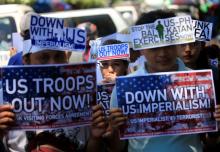
Due to climate change, people — entire tribes and cultures — are losing their homes and are being displaced from their lands. Indeed, the United States military needs to be held accountable for polluting the planet. For example, if preventive measures and legislation like the Green New Deal are not enacted to curb U.S. imperialism, more Indigenous peoples will perish due to climate disasters.

Even in the midst of our lands groaning for their future restoration (Romans 8:22), the body of Christ dismantles the colonial systems that have privatized God’s creation. For in Christ, land and resources are not meant to be segregated but rather shared through hospitality for the flourishing of local communities, especially for the vulnerable and oppressed among us (1 John 3:17-18). In this way, Christ’s body is a new ecology between all lands, nations, and peoples through a common love for each other.
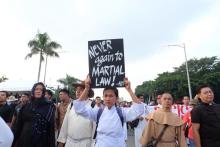
Should the faithful take to the streets in protest to combat political injustice, they will be following the footsteps of religious groups across the globe that have responded with nonviolent action during times of civil resistance.
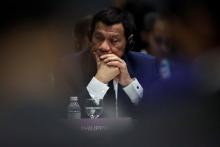
Impeachment suggests charging a president with misconduct that would disqualify them from public office — that’s not what Filipinos as asking for. Unseating Dutarte from office implies that there is a need for people power — a movement to assert democracy and not merely hang ones hopes in a system that has been known to fail or serve only a few. Impeachment calls the government to act, “unseat” calls the general masses to protest and hold government accountable.

For a country that so often claims to purport liberty and democracy, the displacement of 400,000 people in Marawi and the 20,000 killings under Duterte’s drug war should concern the United States. But in the treatment of Jerome Aba, U.S. Customs and Border Protection agents enacted an ideology of scarcity, Islamaphobia, and “America First.” It is an ideology that carries international U.S. military intervention and control as the key to safety. And as a Muslim and peace advocate, Aba was a threat to that and treated as an “enemy combatant”.
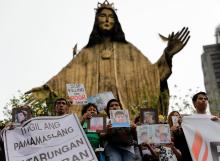
The killing of 17-year-old Kian delos Santos in August sparked a national outcry. Police claimed Kian had been shot in self-defence, but CCTV footage and eyewitness testimony showed how plainclothes officers dragged away the unarmed teenager and shot him dead in an alleyway.
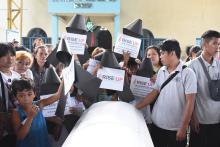
The heightening militarism following Trump’s invitation to Duterte is neither unrelated nor isolated from U.S imperialism in the Philippines — a history that is often manipulated through religious language.

LAST SUMMER, riding the global wave of anti-establishment right-wing populism that would several months later propel Donald Trump into the White House, Rodrigo Duterte took power in the Philippines. He campaigned on the promise that he would launch a brutal war against drugs, criminality, and corruption—like he did as mayor, when he sanctioned death squads that took more than 1,000 lives—and wasted no time implementing his agenda once elected. At the same time, he has deftly made overtures to the political parties on the Left, which has largely quieted their criticism.
As was the case in the 1980s—during the nonviolent People Power movement that toppled Ferdinand Marcos, the dictator who ruled the Philippines for more than two decades—this has left civil society, students, and faith-based organizations to lead the charge not only for social, economic, and environmental justice, but also against the rapidly growing number of drug-related killings.
In January, I traveled to the Philippines to better understand Duterte’s rise and to meet with those organizing to stop him. The international news is filled with headlines of the vicious campaign of extrajudicial executions. To explain his commitment to the cause, Duterte has positively compared himself to Adolf Hitler—saying that he would be “happy to slaughter” 3 million drug users—and pledged that the drug war will continue for his entire six-year term. To date, since he took office more than 8,000 people, or on average more than 30 a day, have been killed by police and so-called “vigilantes,” whom critics argue are often connected to state security forces.
As the drug-related killings mounted, a new ecumenical network of people of faith—including clergy from the Catholic Church, United Church of Christ, and the United Methodist Church—and groups such as Kalipunan ng Damayang Mahihirap (KADAMAY), the largest alliance of urban-poor organizations in the country, launched Rise Up for Life and for Rights in October.

Nine Filipinos were nailed to crosses in three villages in the province of Pampanga, 80 km (50 miles) north of the capital, Manila, drawing hundreds of tourists despite the Catholic church's disapproval of what it sees as a form of folk religion.

On April 10, New York Times journalist Daniel Berehulak received the Pulitzer for his photojournalism on the drug war in the Philippines. His gritty depiction of the killings in the Philippines, under President Rodrigo Duterte’s drug war, is perhaps fitting for Holy Week — calling to mind stark images of blood and crucifixion.

The two major streams of Christian engagement on war are pacifism and just war theory, which comes out of Catholic social teaching. The pacifist response to Syria strikes is clearly opposed. As for the just war analysis, it takes a little explaining, but reaches the same conclusion.

On April 10, Columbia University presented 21 Pulitzer Prizes for achievements in journalism, literature, and music. Notables from the list of social justice-oriented works that received a Pulitzer Prize include: New York Daily News and ProPublica receiving the Public Service award for reporting on evictions of mostly poor minorities carried out by police abusing the law —
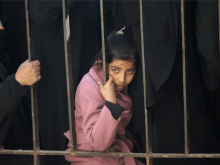
A Catholic priest who fled to the U.S. from war-torn Vietnam as a youth has written to President Trump, offering to surrender his American citizenship so that the president could confer it on a Syrian refugee, who would be barred under Trump’s controversial order banning travelers from Syria and six other Muslim-majority countries.
The Rev. Chuong Hoai Nguyen, a member of the Salesian order, also told Trump he would ask his religious superiors for permission to go live and work in one of the seven countries on the banned list.

At an evacuation hosted by the United Church of Christ in the Philippines, I met the “suffering but struggling Jesus” when I spoke with Bai Bibyaon, the only female chieftan of the Lumad. Bai is over 90 years old, and, like Christ fleeing angry crowds and the surveillance of the Roman Empire, Bai has fled her ancestral land from the violence of the Armed Forces of the Philippines, all to be in sanctuary with her people, the Manobo. She told me, “Our ancestral land, on the Pantaron Mountain, is the only remaining virgin forest in Mindanao. All we want is peace, and to be in our ancestral lands without the Armed Forces of the Philippines or mining companies destroying our land."
